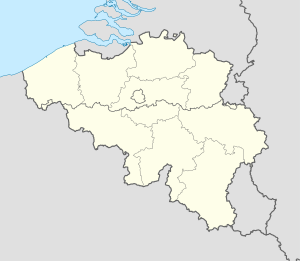Ten Putte Abbey
| Ten Putte Abbey | |
|---|---|
Abdij Ten Putte or Sint-Godelieveabdij | |
 Saint Godelina / Ten Putte Abbey before the 1890 rebuild | |
| General information | |
| Address | Abdijstraat 84 |
| Town or city | Gistel |
| Country | Belgium |
| Coordinates | 51°09′0″N 2°55′08″E / 51.15000°N 2.91889°E |
Ten Putte Abbey (also known as the Saint Godelina Abbey) is a monastery with an abbey in
Parts of the abbey are sometimes open to visitors including the pond, which has been enclosed as a well, the dungeon where Godelina is said to have been incarcerated, the chapel in which she is believed to have performed a miracle, the Abbey Church and a small recently renovated museum concerning the saint.[2]

History
The abbey was founded at some point between 1137 and 1171.
The religious wars that erupted in the second half of the sixteenth century extended destructively into Flanders. On 12 October 1578 the Abbey was attacked by an army of bandits and left in ruins. Only the fourteenth century tower was left standing. The nuns abandoned the undefended site, ending up in Bruges where eventually, in 1623, they set up a new abbey within the city walls in Bovary Street ("de Boeveriestraat") on the south side of the city. The abbey church in Gistel was reconstructed in 1614/15 and became a pilgrimage destination, particularly popular in July when St Godelina's Day is celebrated. Nevertheless, the rest of the site remained in ruins till long after the end of the Eighty Years' War. It continued to be the property of the nuns, now safely in Bruges, till shortly after the outbreak, in 1789, of the French Revolution.[1]
In 1815, following the forced sale of the assets of the bankrupted Anselme de Peellaert, the site came into the hands of a man called Louis Joseph Bortier. He and his immediate heirs left the abbey to deteriorate further. However, in 1889 what remained of the chapel and its estate was sold to the polymath architect Jean-Baptiste Bethune. After a break of 313 years, nuns now returned to St. Godelina. Twelve sister moved in from Bruges. On 2 July 1891 the bishop was able to consecrate a rebuilt monastery, in the neo-Gothic style, using plans drawn up by Bethune. Of the old ruins, only the shell of the old fourteenth century tower was left. The monastery was restored to the status of a Priory in 1891, becoming an Abbey again in November 1934.[1]
Further extensive building development was undertaken between 1952 and 1958 under the direction of the architect Arthur De Geyter.
In 2007 Benedictine nuns were replaced by brothers and sisters from the "Mother of Peace" community.[1] This is a recent order, established in 1992 by Bernard Debeuf and in 1998 recognized by the Bishop of Bruges. The order's spirituality is Marian-Christian and their habits are blue.
References
- ^ a b c d e "Abdij ten Putte .... Beknopte geschiedenis" (in Dutch). Administratief Centrum Gistel. Retrieved 5 June 2015.
- ^ "Godelievemuseum" (in Dutch). Administratief Centrum Gistel. Retrieved 5 June 2015.
- ^ "DE HEILIGEN VAN DE ZEEPOLDER - SINT-GODELIEVE te GISTEL ..... Abdij Ten Putte Abdijstraat 84, 2 km van het centrum". kerknet.be ... TOERISMEPASTORAAL VLAAMSE BISDOMMEN. Archived from the original on May 29, 2006. Retrieved 5 June 2015.
- ^ Vita Godeliph by Drogo, a monk at the former St. Winnoc abbey in Bergues, who wrote down Godelina's biography a few years after her death.


